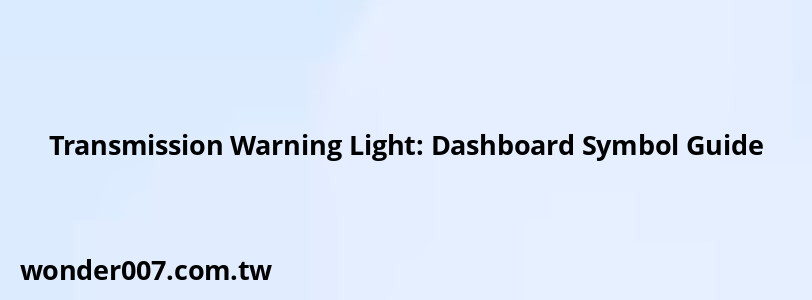Transmission Warning Light: Dashboard Symbol Guide

The transmission warning light is a crucial indicator on your vehicle's dashboard that alerts you to potential issues with your transmission system. This light can appear in various forms depending on your car's make and model.
Transmission Warning Light Symbols
The most common symbols for the transmission warning light include:
- A gear icon with an exclamation point
- A gear icon with a thermometer
- The letter "D" (for drive) with an exclamation point
- A wrench symbol
Some vehicles may display text messages instead of symbols, such as "CHECK TRANSMISSION" or "TRANS TEMP."
Color Variations
Transmission warning lights typically appear in red or amber/yellow. Red usually indicates a more serious issue that requires immediate attention, while amber/yellow suggests a less critical problem that still needs to be addressed soon.
Interpreting the Warning Light
When your transmission warning light illuminates, it could indicate several issues:
- Low transmission fluid: This is one of the most common causes. Low fluid levels can lead to overheating and damage to internal components.
- Overheating transmission: Excessive heat can cause significant damage to your transmission system.
- Electrical problems: Issues with sensors, wiring, or the transmission control module can trigger the warning light.
- Internal mechanical failures: Worn clutches, damaged gears, or other internal issues can activate the light.
- Shift interlock system failure: In automatic transmissions, this system prevents shifting out of park without pressing the brake pedal.
Actions to Take
If your transmission warning light comes on:
1. Safely pull over and turn off the engine
2. Check the transmission fluid level (if possible)
3. Look for signs of fluid leaks under the vehicle
4. If safe to do so, restart the engine to see if the light goes off
5. If the light remains on, avoid driving and contact a professional mechanic
Remember, ignoring a transmission warning light can lead to severe damage and costly repairs. Always prioritize your safety and the health of your vehicle by addressing warning lights promptly.
Related Posts
-
Grease Points for the 2015 Chevy Silverado 1500: A Complete Guide
29-01-2025 • 146 views -
Toyota Forklift Warning Symbols: A Comprehensive Guide
26-01-2025 • 279 views -
6.7 Cummins Oil Drain Plug Size Guide
30-01-2025 • 167 views -
Cruise Control for Mechanical Diesel Engines: A Comprehensive Guide
30-01-2025 • 137 views -
2007 Toyota Camry: A/C Relay Location and Guide
27-01-2025 • 134 views
Latest Posts
-
Power Steering Fluid Leak On Passenger Side
01-02-2025 • 419 views -
Rear Brake Caliper Piston Won't Compress
01-02-2025 • 312 views -
2015 Chevy Traverse AC Recharge Port Location
01-02-2025 • 365 views -
Are O2 Sensors Covered Under Warranty
01-02-2025 • 338 views -
How To Turn Off Paddle Shifters Mercedes
01-02-2025 • 333 views
Popular Posts
-
V12 Engine Costs: What You Need to Know
26-01-2025 • 629 views -
Power Steering and ABS Light On: Causes and Solutions
27-01-2025 • 610 views -
EPC Light: Understanding Causes and Solutions
26-01-2025 • 1019 views -
Hino Warning Lights: Understanding Dashboard Alerts
26-01-2025 • 633 views -
EPC Warning Light: What It Means for Your Vehicle
27-01-2025 • 591 views
